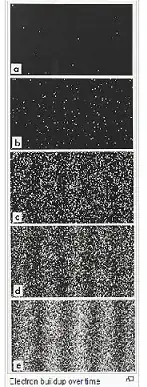I am trying to understand how decoherence explains the observation of only one possible outcome rather than observing the superposition. When the electron goes through the two slits it interferes with itself in a wave, which makes sense. But when it interacts with the detector, how do we know that the states described by detection at each point on the screen are orthogonal? It feels like there should also be outcomes where the electron is also observed at some combination of these locations.
1 Answers
When the electron goes through the two slits it interferes with itself in a wave, which makes sense.
This is not correct. The wave nature of the electron is in the wavefunction $Ψ$ modeling it, and the wave is a probability wave = $Ψ^*Ψ$. A single electron leaves a footprint of a particle in the double slit experiment. The accumulation of a lot of electrons with the same boundary conditions shows the wave nature of the crossection/probability. Here is the experiment one electron at a time hitting the screen.
[ ][2
][2
Each electron leaves a point on the screen, seemingly random in the top frames. It is the accumulation that shows the probability distribution that has wave interference patterns.
But when it interacts with the detector, how do we know that the states described by detection at each point on the screen are orthogonal?
The electron interacts with the atoms in the screen, ionizing them as it passes. It is a much more complicated wavefunction then the one when it scatters through the slits , hitting the screen means new boundary conditions.
It feels like there should also be outcomes where the electron is also observed at some combination of these locations.
The electron is a particle, its wave nature is in the probabiity distributions of the quantum mechanical solution of the scattering problem with its boundary conditions "electron hitting double slits, given distance apart given width "
- 236,935